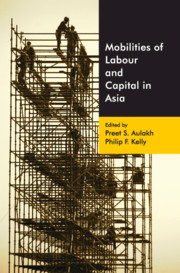Book contents
- Frontmatter
- Contents
- List of Figures
- List of Tables
- List of Appendices
- Acknowledgements
- 1 Introduction: Conceptualizing Labour and Capital Mobilities In and Out of Asia
- SECTION I From Capital to Labour Mobility
- SECTION II From Labour to Capital Mobility
- 7 Skills Development Initiatives and Labour Migration in a Secondary Circuit of Globalized Production: Evidence from the Garment Industry in India
- 8 The Counter Geographies of Globalization: Women's Labour Migration along the Nepal–Persian Gulf Migratory Corridor
- 9 Migration and Developmental Capital in a Punjab Village
- 10 The Production of Nurses for Global Markets: Tracing Capital and Labour Circulation In and Out of Asia
- 11 The Mobility–Oligopoly Nexus in Philippine Property Development
- Notes on Contributors
- Index
8 - The Counter Geographies of Globalization: Women's Labour Migration along the Nepal–Persian Gulf Migratory Corridor
from SECTION II - From Labour to Capital Mobility
Published online by Cambridge University Press: 24 December 2019
- Frontmatter
- Contents
- List of Figures
- List of Tables
- List of Appendices
- Acknowledgements
- 1 Introduction: Conceptualizing Labour and Capital Mobilities In and Out of Asia
- SECTION I From Capital to Labour Mobility
- SECTION II From Labour to Capital Mobility
- 7 Skills Development Initiatives and Labour Migration in a Secondary Circuit of Globalized Production: Evidence from the Garment Industry in India
- 8 The Counter Geographies of Globalization: Women's Labour Migration along the Nepal–Persian Gulf Migratory Corridor
- 9 Migration and Developmental Capital in a Punjab Village
- 10 The Production of Nurses for Global Markets: Tracing Capital and Labour Circulation In and Out of Asia
- 11 The Mobility–Oligopoly Nexus in Philippine Property Development
- Notes on Contributors
- Index
Summary
Introduction
Although migration to India has remained an important source of people's livelihoods in Nepal for years, migration trends beyond India have massively increased in recent years with over 500,000 Nepalese migrating abroad for employment annually (ILO, 2018). A large segment of this migrant population comprises women who originate mainly from Nepal's small rural villages, where most people have adopted traditional mixed livelihood strategies that combine subsistence farming, livestock, and the extraction of local natural resources. The entrenched patriarchy and its various forms of gender-based discriminations and violence, and the penetration of the unregulated global markets even in the smallest of the villages are exerting a tremendous pressure on women's traditional livelihoods, lifestyles, and aspirations that now demand a monetary mode of production while most Nepalese women have been traditionally engaged in informal agricultural sectors and unpaid care and domestic work. The traditional, informal work that women perform does not get recognized even as ‘work’ in society, let alone monetarily paid. There is thus a disjuncture between the mode of production that Nepalese women have been traditionally involved in and the capitalist monetary mode of production required to address the transformed realities wrought by globalization. This disconnect operates as a powerful catalyst for pushing women out of the villages. Succinctly, Nepalese women's outmigration is a phenomenon resulting from an interplay between various intersecting and interlocking pre-existing systems of oppressions and the newly emerging pressures from global markets and climate change. In such a situation, migration has become a key survival strategy for many Nepalese women, despite the legal and institutional barriers created by the state to contain their mobility and the sociocultural stigmas associated with women's migration for work. It should, however, be noted that for women's migration to happen, there is a simultaneous ongoing twin process, the process of women becoming politically aware of the systems of domination on the one hand and their agentic responses and resistance to those systems on the other.
Against the backdrop of the rapidly shifting socio-economic structures spurred on by globalization, this chapter focuses on the phenomenon of women's labour migration along the Nepal–Persian Gulf migratory corridor. Three dimensions of women's labour migration constitute the key contents of the chapter. First, I examine how the fast-paced outmigration of Nepalese women from the country's previously isolated rural spaces has created new spatialities of migration and distinct forms of governmentality.
- Type
- Chapter
- Information
- Mobilities of Labour and Capital in Asia , pp. 172 - 193Publisher: Cambridge University PressPrint publication year: 2020



